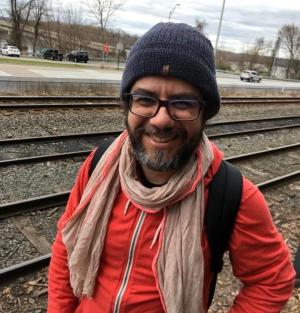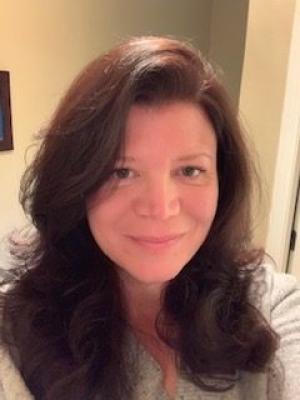Resources
Silhouette Interview with Mitzi Smith of Columbia Theological Seminary.

This semester I am on sabbatical and I decided to shift some gears in my scholarship. I have depended so much on a certain scholarship for my teaching that I feel now another world is opening for me. Since I opened myself to a different relationship with the earth, one of allowing myself to be affected by it, so many things are happening to me. I have always been eager to know everything I can learn about what I hear, touch, and see. My library is way too big and what could have been my retirement is now composed of shelves packed with books. For a few years there has been something growing in me that tells me to slow down that eagerness and sheer desperation. A while ago I lost 1,600 computer files with all my texts, books, scholarship, research, which was devastating. I was thrown into a place of fear, grief, anger, and loss. I felt like I had nothing to rely on. After a long period of reflection, I now wonder if it was my own unconscious telling me: enough with that, that eagerness, that desperation to know. I started pondering my reasons for hiding under those unfulfilled desires. Was I trying to cover up everything that I actually don’t know and am so afraid people will discover about me? What was this desperate need to try to know everything? I am still wrestling with it. And let me say, books haven’t stopped arriving. But now that I am trying to figure out how to pay attention to the earth, I have more to learn and more to read and have to pay attention differently. There is something in me now that is closer to joy than obligation when I read, when I research, when I teach. As I move closer to the earth, I am trying to do what the Brazilian song says: “Caress the earth, know the desires of the earth.” As I do this I am getting closer to myself and whole new worlds are opening up. And that means other ways of learning, teaching, relating. As I learn with indigenous people that the earth is always inhabited by doubles and multiples and other natural and social relationships, I am discovering the joy of my symbiotic being and keep pondering what it means to live in these forms of world relations. My spirituality, always so much dependent on modern forms of thinking, is now becoming freer, as I search for untapped forms of my own traditions and other wisdoms and ways of being. I feel I need to know the world through my belly button, through my intuition, through my perception, but how do I do that? This discovery is pushing me to a world of feelings and sensations, experiences and knowing, that are pretty much anathema for proper scholarship. But I am allowing myself to feel with other beings in ways that I never allowed myself to do and be before. I am gaining the company of other thinkers: other theologians, artists, anthropologists, biologists, geologists, and indigenous thinkers guide me. It was during COVID-19 that the idea of a play came to me. It started with a visitation from my father who was a fantastic artist with a combination of many gifts: a musician, a clown, a theater actor, a song writer, a movie buff, an inventor of games, a poet. During my daily walks I felt his presence. He came to me as a clown and a question started to circulate in my head and my body: How can we engage climate catastrophe, devastation, and grief using humor and laughter? What if a clown walked around the earth figuring out its disasters, sadness, and losses and responded like a clown with naiveté, stupidity, awkwardness, lightness, and humor? Since then, the idea of a play has stayed with me. I have written a script and am looking for funds. But how do we raise funds when all we know in academia is about writing books, editing books, articles, journals, and so forth? Furthermore, the word “clown” is a red nose, oops, a red flag to any serious scholarship. I tried applying for scholarships from the usual places I know to no avail. They all look for innovative thinking, but let us be honest, even the word innovative has limits. Clowning? Really? A friend who proofread my proposal asked, “Do you really need to use the word ‘clown’?” It was a great question and I laughed. Fundraising seeming hopeless, I started to save money. I asked my school for help, and I am getting great support which I am so grateful for, and I feel blessed. But this project will need more money and I am trying in every way I can to get some. I decided to include students and created a class on humor, laughter, and performance in order to do this through pedagogical lenses. I will teach this class with a musician and scholar from the Ifá tradition in Brazil. Here is the course proposal: Humor and Laughter: Resilience and Resistance Across Religious Traditions To be able to laugh, be humorous, and silly are tremendous ways to resist, show love/compassion, and affirm life at a time when depression, anger, sadness, climate catastrophes, and disasters of all kinds are piling up. This course focuses on the following resources of world sense: the Russian Christian tradition of the Holy Fool, Indigenous traditions of Coyote, Afrodiasporic oralities present in the sacred Itan of Ifá, and the multiple presences of Exu with the recognition of the coexistence of positive and negative forces. This course is a theoretical-practical introduction to religious humor and laughter through musical improvisation, sound sculpture, dance, and ritual-performance integrating the senses with the environment. The course will end with a collective performance/play called When Pachamama Meets Gaia. This course is taught by religious teachers/performers who have their foundations crossed by the religious traditions of Christianity and Ifá. Now I need to catch up with my own ideas and proposals. The syllabus is on the way but the most difficult thing now is practicing so my clown can come to life. Next time I will say more about the show and the processes of transformation I am having to go through in order to do this.
Silhouette Podcast Interview with Elizabeth Conde-Frazier director of the Association for Hispanic Theological Education.

With or without our awareness, artificial intelligence routinely influences our classrooms. Chat GPT has brought new challenges to learning and assessment. How can Chat GPT become a tool of the course? What new practices will be needed to measure learning given students’ use of Chat GPT? What conversations can faculties convene to learn the nuances of this technology and how it impacts pedagogy? As new technologies emerge, what is adult learning?

I was on educational leave in the fall and working, primarily, on a religion and disability textbook. Of the many things I learned (one of which was how very little it turns out I know about religion, the subject for which I have my doctorate; this was humbling!), the fact that there is relatively little treatment of disability in religious studies became quite clear to me. Disability goes unmentioned in canonical texts in the field and introductory textbooks, including the one from which I assign chapters. Unless I was reading specific volumes devoted to the topic--or poking around our disciplinary journal, which we’re lucky to have--it rarely came up. As a person who attends to disability regularly in lots of parts of my personal and professional life (e.g., this recent presentation on inclusive pedagogy for AAR), I also have to admit that I haven’t really integrated disability into my courses, besides the specific one I teach on Religion and Disability. In the past, I’ve made no mention of disability in my lower-level, introductory Religions of the World classes or my upper-level electives, such as Religion and Film or Race and Religion. This is not the case with other markers of identity—gender, class, race—which I routinely note, represent, and try to get students to reflect on. A quick search of our Wabash blog posts shows that disability is not a popular topic. And, in general, “higher ed has been slow to recognize disability as an identity group or include it in programming around diversity and inclusion.” Some scholars, like Jay Domage in Academic Ableism, have even argued that higher education in the U.S. has been specifically designed to exclude people with disabilities. Disabled people account for the largest minority group in the world. On college campuses, we really don’t know just how many students and colleagues have a disability because there is so much underreporting, likely due to all the barriers to disclosure. It’s a lot, though. And, as with any demographic, including the religious, there is immense diversity within the disability community. Disabilities can range from hearing to learning, from movement to mental health. They can be lifelong, from birth, or shorter term. Some folks are proud of their disability and wouldn’t change it for the world, believing it gives them gifts and connections they wouldn’t have otherwise. Other folks with disabilities experience impairment and suffering and wish their lives had turned out differently. Some can pass, although it’s not always beneficial to them. Others have disabilities that are always or immediately apparent to others. Some people prefer “person-first” language (e.g., “a person with ADHD”); others prefer “identity-first” language (“a deaf person”), which allows them to claim, unapologetically, disability as a central and important part of who they are. People with the same disability can experience it very differently. What binds people together in this group is the way society is still not designed for them and the barriers they experience (environmental, social, legal) that result. Awareness and understanding about disability remains woefully lacking on college campuses. COVID has not helped. College students with disabilities experience discouragement, debasement, insecurity, isolation, and cycles of disempowerment. Accommodations are resisted, disabilities are disbelieved. And, when we talk about disability, we tend to think only of students. However, of course, our colleagues may have disabilities too. In our religion classrooms, we can assume there will be students with disabilities enrolled. We don’t need to wait for disclosure, some “accommodation” letter about a single person, to begin considering how to make our courses accessible and welcoming. Let’s be proactive, rather than reactive. This is the entire point of Universal Design for Learning, which I encourage everyone to spend time learning more about. (UDL benefits everyone, not just specific individuals with specific disabilities.) The gist is to preemptively assume variability and then to design for it, proliferating options and providing multiple entry points to the learning experience. (And yes, it’s also basic stuff like turning on closed captions whenever you show a video in class or making sure podcasts you assign have transcripts.) It’s about moving away from conceiving disability as deficit, to embracing the opportunities and assets of having a diverse student population in our classrooms.